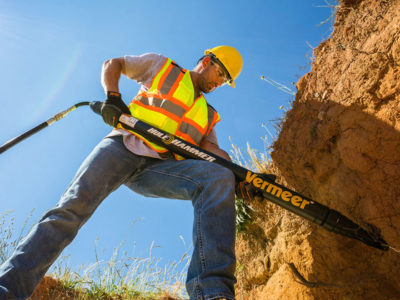Updated September 11, 2023
Pneumatic piercing tools, like the Vermeer Hole Hammer®, have been around for a long time, and are still an efficient way to perform small-diameter bores ranging from 15 feet to 70 feet (4.6 m to 21.3 m) in length. With an increasing number of utilities being installed underground or replaced in residential urban environments where space is too tight for other trenchless solutions, there has been a resurgence in the usage of piercing tools.
If you’re new to piercing tools or just looking to refresh your skills, here’s a quick guide to help you get started.
Where and when to use piercing tools
According to Aaron James, product specialist for Vermeer MV Solutions, piercing tool usage has been growing in recent years. This is happening in communities that are either installing fiber to the home or upgrading existing utility lines. “In new housing developments, curbs, gutters, sidewalks and driveways often are poured before new homes are built,” he explained. “To avoid damaging those hard surfaces, contractors need a quick solution to install buried utilities like water, gas, telecom, fiber and irrigation systems. Tools like the Vermeer Hole Hammer fit their needs since they are a relatively low-cost investment and don’t require a lot of setup time. Also, since they run off a standard portable air compressor, many contractors already have an adequate power source in their equipment fleet; and if they don’t, they can find one at almost any rental yard.”
Piercing tools are also an excellent solution for replacing or upgrading utilities in older neighborhoods and urban areas. “In established areas, jobsites can be pretty tight, which limits the use of horizontal directional drills,” James explained. “Since piercing tools only require an entrance and exit pit a little larger than the model being used, they are an ideal solution for these tight applications.”
Finally, if you’re looking to break out on your own, piercing tools can be a relatively low-cost way to get established, and there is a healthy market for stitch boring in residential areas.
Equipment needs
An air compressor, hoses, an in-line lubricator, the piercing tool itself, and something to dig the entrance and exit pits are all you need to get started in this trenchless line of work. The compressor powers the tool, and the in-line lubricator helps reduce any friction between internal components.
“Contractors just getting started with piercing tools may want to consider renting what they need before investing in their own setup,” James said. “However, if they know they will use it a few times a year, investing in their own equipment may make sense.”
Also, while there are many makes and models of pneumatic tools on the market, James said most contractors only need one or two different piercing tools in their fleet. “Contractors need to choose a tool that is larger in diameter than the product they are installing, with the right type of head for the ground conditions,” he explained.
“In softer soils, crews can usually get by with a smaller-sized piercing tool with a fixed head,” James explained. “Smaller units are, of course, lighter and don’t require as large of a pit to be dug, so they are efficient to maneuver. Also, a fixed head can perform well in loose soil, sand and loamy material.”
If you find yourself working in clay or rocky grounds, you may want to step up to a larger piercing tool. James said the larger models deliver more impact force behind every blow to help break up more solid material. “The active head works to help chisel away or bust up small obstructions in its path,” he said.
Servicing and support
Piercing tools produce a lot of force as they hammer their way through the ground. The ability to perform service work in the field is crucial, and access to parts and dealer support are key. To stay productive, the brand name on the side of your piercing tool matters.
James said that factory-trained technicians at Vermeer dealers across the globe are well-versed on piercing tools. And MV Solutions has designed its line of Hole Hammer positive turn reverse piercing tools to be serviced on the back of a pickup tailgate.
“The Vermeer positive turn reverse Hole Hammer is designed with fewer moving parts than other piercing tools on the market to help reduce the number of potential issues,” said James. “Also, we’ve made it efficient to replace common wear components in the field and have dealers nearby ready to help if a contractor needs more support.”
Next steps
Hopefully this guide for getting started with piercing tools provided a little perspective for you and your team. As you can see, these pneumatic trenchless tools deliver substantial value for installing utilities, telecom, fiber and irrigation lines.
If you have questions or are ready to add piercing tools to your fleet, contact your local Vermeer dealer. They will be happy to help. You can also learn more about the Hole Hammer line.
Vermeer MV Solutions, Inc. reserves the right to make changes in product engineering, design and specifications; add improvements; or discontinue manufacturing or distribution at any time without notice or obligation. Equipment shown is for illustrative purposes only and may display optional accessories or components specific to their global region. Please contact your local Vermeer dealer for more information on machine specifications.
Vermeer, the Vermeer logo and QuickDig are trademarks of Vermeer Manufacturing Company in the U.S. and/or other countries.
© 2023 Vermeer Corporation. All Rights Reserved.
